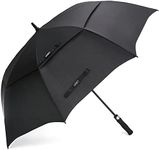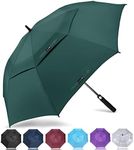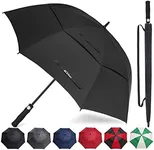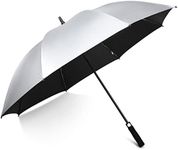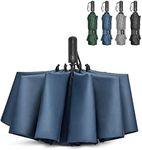Buying Guide for the Best Golf Umbrellas
Choosing the right golf umbrella can make a big difference in your comfort and protection on the course. Golf umbrellas are designed to shield you from rain, wind, and even sun, but not all umbrellas are created equal. When shopping for a golf umbrella, it's important to consider the size, weight, material, and features that best match your needs. Think about how often you'll use it, the typical weather conditions you face, and how much convenience or portability you require. By understanding the key specifications, you can select an umbrella that keeps you dry and comfortable without being a hassle to carry or use.Canopy SizeCanopy size refers to the diameter of the umbrella when it is fully opened. This is important because it determines how much coverage you get from rain or sun. Golf umbrellas typically range from about 54 inches to 68 inches or more. Smaller canopies (around 54-58 inches) are lighter and easier to handle, making them suitable for solo use or for those who prefer less bulk. Medium sizes (about 60-64 inches) offer a good balance between coverage and manageability, ideal for most golfers. Larger canopies (66 inches and above) provide maximum protection and can cover you and your golf bag, but they can be heavier and more difficult to manage in strong winds. Choose a size based on whether you want to protect just yourself or also your equipment, and consider your ability to comfortably carry and use a larger umbrella.
Frame MaterialThe frame material is what gives the umbrella its structure and strength. Common materials include fiberglass, steel, and aluminum. Fiberglass frames are popular because they are lightweight, flexible, and resistant to rust and breakage, making them a good choice for windy conditions. Steel frames are strong but heavier and can rust over time if not cared for. Aluminum frames are light and rust-resistant but may not be as durable as fiberglass. If you often play in windy or stormy weather, a fiberglass frame is usually the best option. For occasional use in mild conditions, steel or aluminum may suffice.
Canopy MaterialCanopy material affects how well the umbrella repels water and resists wear. Most golf umbrellas use polyester or nylon fabric. Polyester is durable, dries quickly, and resists fading from the sun, making it a common choice. Nylon is also strong and water-resistant but can be more expensive. Some canopies have special coatings for extra water repellency or UV protection. If you play in heavy rain or strong sun, look for a canopy with a water-repellent or UV-protective coating. For general use, standard polyester or nylon will work well.
Wind ResistanceWind resistance refers to how well the umbrella can withstand strong gusts without flipping inside out or breaking. Features like double-canopy designs (where there are two layers of fabric with vents) allow wind to pass through, reducing the risk of inversion. Reinforced frames and flexible ribs also help. If you play in areas known for windy conditions, prioritize umbrellas with wind-resistant features such as double canopies and flexible, reinforced frames. For calmer environments, standard designs may be sufficient.
Handle TypeThe handle is the part you grip, and its design affects comfort and usability. Handles can be straight or curved and are made from materials like rubber, foam, or plastic. Ergonomic handles with non-slip grips are more comfortable to hold, especially for long periods. If you walk the course or carry your umbrella a lot, look for a handle that feels comfortable and secure in your hand. If you use a golf cart, a straight handle may fit better in the cart’s umbrella holder.
Opening MechanismThe opening mechanism determines how you deploy the umbrella. Manual umbrellas require you to push or pull the canopy open, while automatic umbrellas open with the press of a button. Automatic mechanisms are convenient and quick, especially if you need to open the umbrella in a hurry. However, they can add a bit of weight and complexity. If you value speed and ease, an automatic opening is a good choice. If you prefer simplicity and reliability, a manual mechanism may be better.
WeightWeight is important because you may need to carry the umbrella for several hours. Lighter umbrellas are easier to carry and less tiring, but they may sacrifice some durability or wind resistance. Heavier umbrellas can be sturdier but may become a burden over a long round. Consider how much walking you do and how much weight you’re comfortable carrying. If you walk the course, a lighter umbrella is preferable. If you use a cart, weight may be less of a concern.
